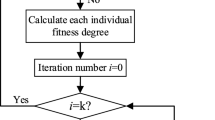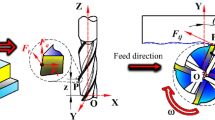Abstract
Tool remaining useful life prediction (RUL) and parameters optimization are very important for the normal operation of the machining system, the full use of the tool excellent performance, and the tool health management. This paper proposes a RUL prediction based on WOA-optimized XGBoost with multidomain feature fusion. Based on the milling 508III experiment, Kernel principal component analysis (KPCA) is used for multi-domain sensitive feature dimensionality reduction fusion. The whale optimization algorithm (WOA) is used to optimize the extreme gradient lifting integrated learning (XGBoost) method, and a WOA-XGBoost correlation model integrating features and tool life evolution is established to predict the RUL. The effectiveness and reliability are verified by comparison with other methods and milling experiments. A parameter optimization method combining multi-objective genetic algorithm and multi-attribute decision-making is proposed. Based on tool life and cutting force experiments, the multi-objective cutting parameter optimization problem is modeled to provide a theoretical basis for cutting parameter optimization. Taking tool life, cutting efficiency, and cutting force as evaluation indicators, the optimal cutting parameter combination that can be accepted by all optimization objectives is obtained. Results show that the prediction performance of the RUL prediction method proposed is better compared with other ensemble learning methods adopted in this paper. Based on the limited experimental data, the RUL can be predicted effectively and reliably. Through the parameter optimization method proposed, the acceptable optimal combination is: the cutting speed is 284.78 m/min, feed per tooth is 0.3 mm/z, and axial cutting depth is 1.999 mm. These findings may provide theoretical basis and technical support for promoting the intelligent development of tool status warning and cutting process optimization in machining.
















Similar content being viewed by others
Data availability
The data that support the results of this article are included within the article.
References
Karandikar J (2019) Machine learning classification for tool life modeling using production shop-floor tool wear data. Procedia Manuf 34:446–454
Li H, Wang W, Li ZW, Dong LY, Li QZ (2020) A novel approach for predicting tool remaining useful life using limited data. Mech Syst Signal Proc 143:106832
Dadgari A, Huo DH, David S (2018) Investigation on tool wear and tool life prediction in micro-milling of Ti6Al4V. Nanotechnol Precision Eng 1(4):218–225
Sagar CK, Priyadarshini A, Gupta AK, Mathur D (2020) Experimental investigation of tool wear characteristics and analytical prediction of tool life using a modified tool wear rate model while machining 90 tungsten heavy alloys. Proc Inst Mech Eng Part B-J Eng Manuf 23(1):95–102
Karam S, Centobelli P, Addona DMD, Teti R (2016) Online prediction of cutting tool life in turning via cognitive decision making. Procedia CIRP 41(2):269–273
Liu YC, Hu XF, Sun SX (2019) Remaining useful life prediction of cutting tools based on support vector regression. IOP Conference Series: Mater Sci Eng 576:012021
Wang Y, Deng C, Wu J, Yao X (2015) Failure time prediction for mechanical device based on the degradation sequence. J Intell Manuf 26(6):1181–1199
Li W, Zhang S, Rakheja S (2016) Feature denoising and nearest-farthest distance preserving projection for machine fault diagnosis. IEEE Trans Ind Inform 12(1):393–404
Sun C, Wang P, Yan R, Gao RX (2019) Machine health monitoring based on locally linear embedding with kernel sparse representation for neighborhood optimization. Mech Syst Signal Proc 114(4):25–34
Li CB, Yu BS, Xiao QG, Sun X, Lv Y (2021) A cutting parameter energy-saving optimization method for CNC turning batch processing considering tool wear. J Mech Eng 57(1):217–229
Hu XJ, Yang B, Luo Y (2014) Intelligent optimization of machining parameter based on fuzzy theory and genetic algorithm and neural network hybrid. Tool Eng 48(2):214–221
Deng CH, Meng HJ, Zhang H, Wang LL (2016) A Multi-objective comprehensive decision method for machine tool machining process parameters based on combination weight. China Mech Eng 27(21):2902–2908
Adarsha KK, Ratnam C, Venkata RK, Murthy BSN (2019) Experimental studies of machining parameters on surface roughness, flank wear, cutting forces and work piece vibration in boring of AISI 4340 steels: modelling and optimization approach. SN Appl Sci 1(1):1–12
Li B, Tian XT, Zhang M (2020) Modeling and multi-objective optimization of cutting parameters in the high-speed milling using RSM and improved TLBO algorithm. Int J Adv Manuf Technol 111(7–8):2323–2335
Osorio-Pinzon JC, Abolghasem S, Marañon A, Casas-Rodriguez JP (2020) Cutting parameter optimization of Al-6063-O using numerical simulations and particle swarm optimization. Int J Adv Manuf Technol 111(9):2507–2532
Qiu Y, Zhou J, Khandelwal M, Yang HT, Yang PX, Li CQ (2020) Performance evaluation of hybrid WOA-XGBoost, GWO-XGBoost and BO-XGBoost models to predict blast-induced ground vibration. Eng Comput 38(5):1–18
Chen Y, Cheng A, Zhang C, Chen SW, Ren ZC (2021) Rapid mechanical evaluation of the engine hood based on machine learning. J Braz Soc Mech Sci Eng 43(7):345
Shi YS, Li J, Ren JR, Zhang K (2022) Prediction of residual service life of lithium-ion battery using WOA-XGBoost. Energy Storage Sci Technol 11(10):3354–3363
Seyedali M, Lewis A (2016) The whale optimization algorithm. Adv Eng Softw 95(5):51–67
Ding HQ, Wu ZY, Zhao LC (2020) Whale optimization algorithm based on nonlinear convergence factor and chaotic inertial weight. Concurr Comput-Pract Exp 32(24):e5949
Qu S, Zhao JB, Wang TR (2017) Experimental study and machining parameter optimization in milling thin-walled plates based on NSGA-II. Int J Adv Manuf Technol 89:2399–2409
Li B, Tian X, Zhang M (2020) Modeling and multi-objective optimization of cutting parameters in the high-speed milling using RSM and improved TLBO algorithm. Int J Adv Manuf Technol 111(7–8):1–13
Venkatesan K, Ramanujam R, Joel J, Jeyapandiarajan P, VigneshM TDJ, Krishna RV (2014) Study of cutting force and surface roughness in machining of Al alloy hybrid composite and optimized using response surface methodology. Procedia Eng 97:677–686
Song YL, Zou MY, Chen X, Deng JY, Du T (2019) Parameter optimization of passive heat supply tower of ground source heat pump based on NSGA-II. Sol Energy 190(24):453–464
Yusoff Y, Ngadiman MS, Zain AM (2011) Overview of NSGA-II for optimizing machining process parameters. Procedia Eng 15:3978–3983
Shi YL, Wang Q, Wang QL, Wang WQ, Fang JG (2022) Research on grades of vine tea based on entropy TOPSIS method and grey correlation analysis. Chinese Trad Herbal Drugs 53(17):5504–5512
Wu PC, He Y, Li YF, He JS, Liu XQ, Wang YL (2022) Multi-objective optimisation of machining process parameters using deep learning-based data-driven genetic algorithm and TOPSIS. J Manuf Syst 64:40–52
Nguyen VC, Nguyen TD, Tien DH (2021) Cutting parameter optimization in finishing milling of Ti-6Al-4 V titanium alloy under MQL condition using TOPSIS and ANOVA analysis. Eng Technol Appl Sci Res 11(1):6775–6780
Li XX, Wang KS, Liu LW, Jing X (2011) Application of the entropy weight and TOPSIS method in safety evaluation of coal mines. Procedia Eng 26:2085–2091
Acknowledgements
Besides, the authors are grateful to the anonymous reviewers for valuable comments and suggestions, which helped to improve this study.
Funding
This work was financially supported by National Natural Science Foundation of China (No. 52175394) and Joint Guidance Project of Heilongjiang Provincial Natural Science Foundation (No. LH2021E083).
Author information
Authors and Affiliations
Contributions
Study conception and design: Yaonan Cheng, Xiaoyu Gai.
Drafting of manuscript: Xiaoyu Gai.
Method proposed and interpretation of data: Xiaoyu Gai, Rui Guan.
Acquisition and analysis of data: Yingbo Jin, Mengda Lu, Shilong Zhou, Jing Xue.
Corresponding author
Ethics declarations
Ethical approval
Not applicable.
Consent to participate
The authors have consent to participate.
Consent for publication
The authors have consent to publish.
Competing interests
The authors declare no competing interests.
Additional information
Publisher's Note
Springer Nature remains neutral with regard to jurisdictional claims in published maps and institutional affiliations.
Rights and permissions
Springer Nature or its licensor (e.g. a society or other partner) holds exclusive rights to this article under a publishing agreement with the author(s) or other rightsholder(s); author self-archiving of the accepted manuscript version of this article is solely governed by the terms of such publishing agreement and applicable law.
About this article
Cite this article
Gai, X., Cheng, Y., Guan, R. et al. Tool remaining useful life prediction and parameters optimization in milling 508III steel. Int J Adv Manuf Technol 129, 1741–1757 (2023). https://doi.org/10.1007/s00170-023-12310-3
Received:
Accepted:
Published:
Issue Date:
DOI: https://doi.org/10.1007/s00170-023-12310-3




